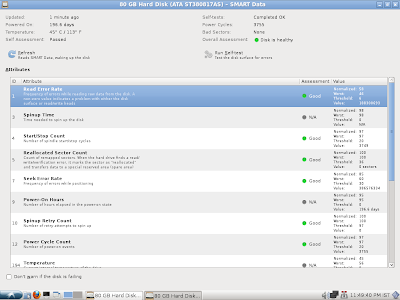I stumbled upon this term when we had to collect information about our processors,hard drives and system memory. So I tried to find a little more about this lifesaving technology.So here's what i found....
S.M.A.R.T. stands for Self-Monitoring, Analysis and Reporting Technology and it tries to anticipate hard drive failure by keeping an eye on many of the drive’s crucial properties.
S.M.A.R.T. support is built into most ATA and SCSI hard drives these days. If a hard drive has S.M.A.R.T. support , then it keeps monitoring itself for signs which may lead to a drive failure and warns the user/administrator so that he/she may be able to copy the data to another location before the drive dies.
The first drive monitoring system was introduced by IBM in 1992. Another variant was created by computer manufacturer Compaq and disk drive manufacturers Seagate, Quantum, and Conner which was named IntelliSafe. Compaq submitted their implementation to Small Form Committee for standardization in early 1995. It was supported by various other companies including IBM and was chosen by the committee as the standard due to its flexibility and was named S.M.A.R.T.. According to PCtechguide’s page on S.M.A.R.T. , the smart technology has evolved from just monitoring hard drive activity for data retrieved by operating system to testing all data and sectors of a drive using “off-line data collection”(when drive is inactive).
A Little Info
The most basic information provided by the SMART system is the SMART status. It has two values , “threshold exceeded” or “threshold not exceeded”,which correspond to “drive about to fail” or “drive okay”.A “threshold exceeded” value suggests that the drive is about to fail,i.e., it will not be able to work according to its specifications anymore.
For more information on a drive’s health, SMART attributes can be examined. there are various types of SMART attributes like read error rate,throughput performance,spin up time etc. which have different threshold values defined by the manufacturer and tend to vary from one manufacturer to another. If a attributes threshold is crossed , it may report an impending drive failure, but it all depends on the implementation of SMART attributes by the manufacturer as these attributes were not included in the standard. A list of all the SMART attributes and meanings of their raw values is available at http://en.wikipedia.org/wiki/S.M.A.R.T.
Furthermore, some drives also support various self tests and maintenance tests as a part of SMART system to reduce the chances of sudden disk failure.
-offline
-short
-long
-conveyance
In linux, one can view the SMART properties using the disk utility or by using smartmontools' smartctl utility. A detailed article on how to use this utility and more about SMART is available at http://www.linuxjournal.com/magazine/monitoring-hard-disks-smart (i havn’t tried it yet, if anybody tries it ,let me know about the results).
disk utility screenshots


links and resources:
http://www.pctechguide.com/31HardDisk_SMART.htm
http://www.linuxjournal.com/magazine/monitoring-hard-disks-smart
http://en.wikipedia.org/wiki/S.M.A.R.T.
SMART.... ;-)
ReplyDeleteGr8 work Nishant..
wow!!well written..covered d point very nicely.keep it up!
ReplyDelete@arjun,sakshi..thnx guys...
ReplyDeleteThis comment has been removed by the author.
ReplyDeleteS.M.A.R.T. blog...simplistic language n interesting to read.I gathered that this technology is inbuilt in the hard disk n cannot be installed externally.Is that correct?
ReplyDelete@shruti-thanks and yes , you are right...you can install advanced utilities to check the s.m.a.r.t. attributes of the hard drive but the technology is inbuilt.
ReplyDeletePretty nice article. Well done.
ReplyDeleteKeep posting. :)
This comment has been removed by the author.
ReplyDelete@arjun- thanx a lot :)
ReplyDeletequite informative, well written and new kind of stuff..i liked it
ReplyDeleteI recently came across your blog and have been reading along. I thought I would leave my first comment. I don't know what to say except that I have enjoyed reading. Nice blog. I will keep visiting this blog very often. Top 10 external hard drives
ReplyDeleteI found this is an informative and interesting post so i think so it is very useful and knowledgeable. I would like to thank you for the efforts you have made in writing this article. Games Online
ReplyDelete